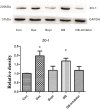Dexmedetomidine may decrease the bupivacaine toxicity to heart
- PMID: 34307889
- PMCID: PMC8284331
- DOI: 10.1515/med-2021-0311
Dexmedetomidine may decrease the bupivacaine toxicity to heart
Abstract
Objective: The purpose of our study was to explore the effect of dexmedetomidine on cardiac tolerance to bupivacaine.
Method: Human coronary endothelial cells were used to establish in vitro model. They were randomly divided into control (Con) group, dexmedetomidine (Dex) group, bupivacaine (Bupi) group, dexmedetomidine + bupivacaine group (DB group), and dexmedetomidine + bupivacaine + PI3K inhibitor (DB-inhibitor) group. Cell activity was measured by Cell counting kit-8 (CCK-8). Transwell was used to detect cell permeability. Western blotting was used to detect the protein expression of related factors.
Results: There were no notable differences in cell activity among the five groups (P > 0.05). Dexmedetomidine significantly reduced the permeability of endothelial cells to bupivacaine and increased the protein expression of Zonulaoeeludens-1 (ZO-1) (P < 0.01). However, the aforementioned effects of dexmedetomidine were disappeared after the addition of PI3K inhibitors. Furthermore, Dex and DB markedly increased the protein expression of PI3K, p-Akt, and p-PTEN in comparison with Con group (P < 0.001), but there was no significant difference in p-PTEN among DB-inhibitor, Con, and Bupi groups (P > 0.05).
Conclusion: Dex reduced Bupi-induced vasopermeability through protein expression of ZO-1 and PI3K/Akt pathway, which may lead to the decrease of Bupi-induced cardiotoxicity.
Keywords: PI3K/Akt pathway; ZO-1; bupivacaine; cardiac tolerance; dexmedetomidine.
© 2021 Zhousheng Jin et al., published by De Gruyter.
Conflict of interest statement
Conflict of interest: All authors declare that they have no conflict of interest
Figures




References
-
- Neal JM , Brull R , Chan VWS , Granr SA , Horn JL , Liu SS , et al. The ASRA evidence-based medicine assessment of ultrasound-guided regional anesthesia and pain medicine: executive summary. Reg Anesth Pain Med. 2010;35:S1–9. - PubMed
- Neal JM, Brull R, Chan VWS, Granr SA, Horn JL, Liu SS. et al. The ASRA evidence-based medicine assessment of ultrasound-guided regional anesthesia and pain medicine: executive summary. Reg Anesth Pain Med. 2010;35:S1–9. - PubMed
-
- Kien NT , Giang NT , Van Manh B , Cuong NM , Dinh NV , Pho DC , et al. Successful intralipid-emulsion treatment of local anesthetic systemic toxicity following ultrasound-guided brachial plexus block: case report. Int Med Case Rep J. 2019;12:193–7. - PMC - PubMed
- Kien NT, Giang NT, Van Manh B, Cuong NM, Dinh NV, Pho DC. et al. Successful intralipid-emulsion treatment of local anesthetic systemic toxicity following ultrasound-guided brachial plexus block: case report. Int Med Case Rep J. 2019;12:193–7. - PMC - PubMed
-
- Chen Y , Xia Y , Liu L , Shi T , Shi K , Wang Q , et al. Lipid emulsion reverses bupivacaine-induced asystole in isolated rat hearts: concentration-response and time-response relationships. Anesthesiology. 2010;113:1320–5. - PubMed
- Chen Y, Xia Y, Liu L, Shi T, Shi K, Wang Q. et al. Lipid emulsion reverses bupivacaine-induced asystole in isolated rat hearts: concentration-response and time-response relationships. Anesthesiology. 2010;113:1320–5. - PubMed
LinkOut - more resources
Full Text Sources
Research Materials
Miscellaneous
